Interesting Facts About Michael Jackson You Never Knew
You might think you know everything about Michael Jackson, but there's more to the King of Pop than meets the eye. Did you know he once tried to buy Marvel Comics for $25 million? Or that he owned gravity-defying shoes patented for his iconic dance moves? Jackson was even crowned a king in Africa during a 1989 visit to the Ivory Coast. His Neverland Ranch boasted hidden features like a 50-seat movie theater and a functional train station. Jackson's life was filled with unique acquisitions and experiences, from his famous chimpanzee Bubbles to his groundbreaking Soviet TV appearance. These lesser-known facts offer a glimpse into the complex world of this legendary artist.
This post may contain affiliate links. If you make a purchase through these links, I may earn a commission at no additional cost to you. Additionally, portions of this post may be generated using artificial intelligence (AI) technology. While we strive for accuracy, please be aware that AI-generated content may not always be perfect and should be fact-checked when necessary.
The Spatula Scoops
- Michael Jackson attempted to purchase Marvel Comics for $25 million in the mid-1990s to create synergy between music and comic narratives.
- Jackson owned llamas named Lola and Louis that often accompanied him during recording sessions, creating a unique studio atmosphere.
- He patented an anti-gravity shoe design that enabled his iconic dance moves, particularly for the "Smooth Criminal" performance.
- Jackson was crowned "King of Pop" during a visit to the Ivory Coast in 1989, showcasing his global cultural impact.
- He established a personal medical center in Los Angeles staffed with specialized professionals to manage his ongoing health issues.
The Elephant Man's Remains
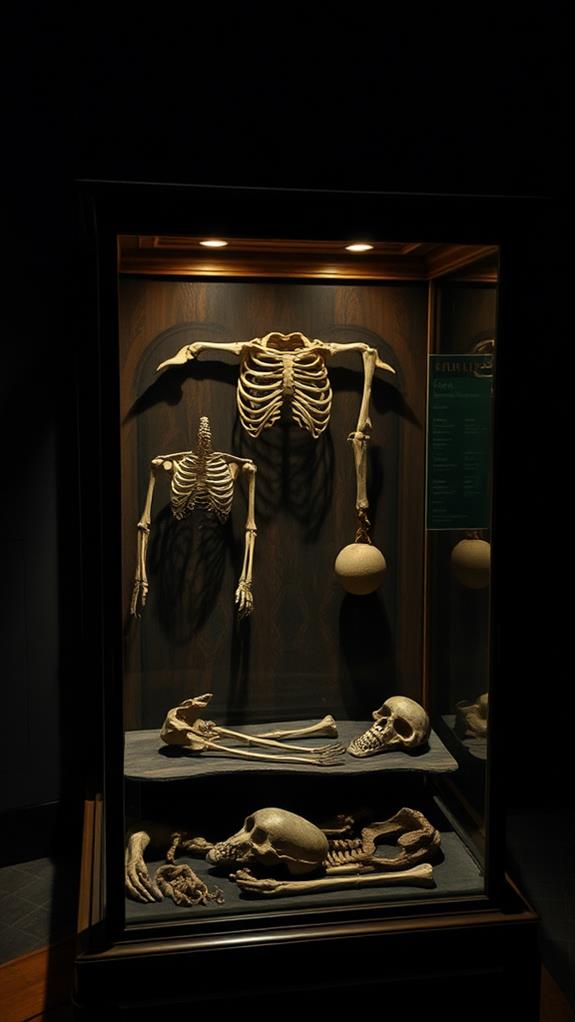
The bizarre tale of Michael Jackson's acquisition of the Elephant Man's remains is a proof of the pop star's eccentric nature. In 1987, Jackson purchased the skeletal remains of John Merrick, famously known as the Elephant Man, for a staggering $1.5 million. This unusual acquisition sparked widespread media attention and public fascination, cementing Jackson's reputation for unconventional behavior.
You might wonder about Jackson's motivations. The pop icon claimed his intent was to raise awareness and express compassion for individuals with deformities and disabilities, aligning with his humanitarian efforts. However, this purchase also ignited ethical debates about the morality of owning human remains.
Initially, Jackson had plans to exhibit the Elephant Man's remains publicly. But he later abandoned this idea, citing concerns about potential exploitation and media sensationalism. The remains stayed in Jackson's possession until his death in 2009, after which they were returned to the Royal London Hospital.
This peculiar chapter in Michael Jackson's life highlights the complex interplay between his humanitarian aspirations and his penchant for the extraordinary, offering a unique glimpse into the mind of one of pop culture's most enigmatic figures.
Gravity-Defying Dance Shoes
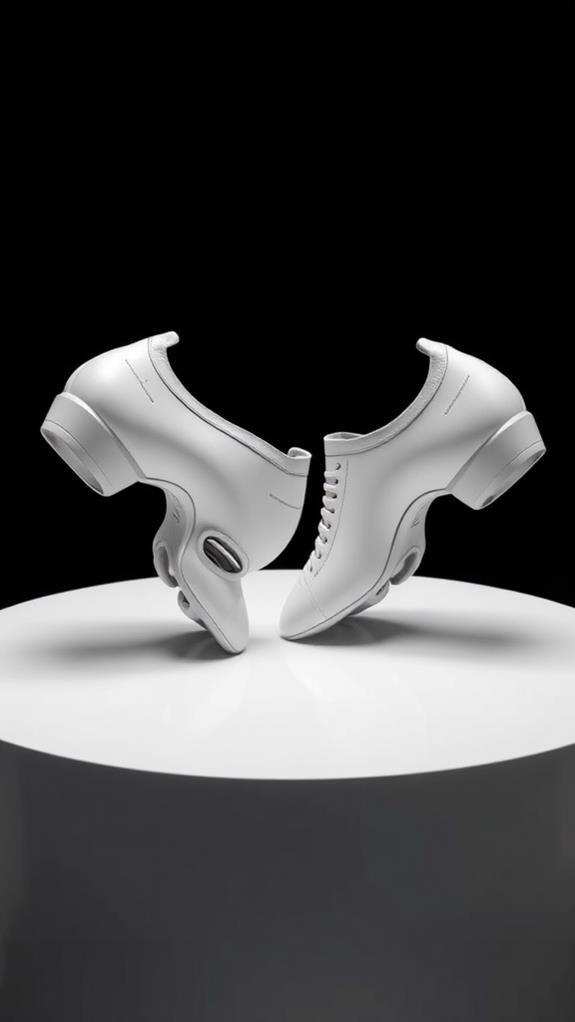
You might be surprised to learn that Michael Jackson's iconic dance moves weren't just about his incredible talent; they also involved some clever engineering. Jackson patented a special shoe design that allowed him to perform gravity-defying moves like the moonwalk and his famous 45-degree lean. These innovative shoes, featuring a heel that could lock onto a stage peg, revolutionized stage performance techniques and showcased Jackson's ability to blend artistry with technology.
Patented Anti-Gravity Footwear Design
Michael Jackson's innovative spirit extended beyond his music and dance moves, leading him to secure a U.S. patent for a groundbreaking shoe design. The patented footwear, known as anti-gravity shoes, allowed him to perform gravity-defying dance moves that left audiences in awe. These specially designed shoes featured a slotted heel that could lock into a stationary object on stage, providing the necessary support for Jackson to execute his iconic moonwalk and an impressive 45-degree forward lean.
You might've seen this remarkable lean in action during Jackson's "Smooth Criminal" performances. The shoes' design was first showcased during rehearsals for the music video, demonstrating how technology could enhance live performances. This innovation set a new standard for stage aesthetics, blending artistry with cutting-edge design.
Jackson's focus on dance technology inspired countless performers and led to wider acceptance of innovative footwear in the entertainment industry. By pushing the boundaries of what was possible on stage, he not only revolutionized his own performances but also influenced the future of live entertainment. The impact of his patented anti-gravity shoes continues to resonate in the dance world today.
Revolutionizing Stage Performance Techniques
While many artists have pushed the boundaries of stage performance, few have revolutionized it quite like Michael Jackson with his gravity-defying dance shoes. You might not know that Jackson held a U.S. patent for these innovative shoes, which allowed him to lean at a seemingly impossible 45-degree angle during his performances.
The patented technology behind these shoes included a slot that secured the dancer to the stage, enhancing both safety and performance capabilities. This ingenious design enabled Jackson to execute his signature dance moves, including the moonwalk, with unparalleled fluidity and precision. By incorporating this technology into his live performances, Jackson set a new standard for stage presence and choreography.
The impact of Jackson's innovative footwear extends beyond his own performances. It has influenced modern dance techniques and sparked discussions about integrating technology with performance art. When you watch contemporary stage shows that feature gravity-defying stunts, you're witnessing the legacy of Jackson's pioneering spirit. His patented dance shoes exemplify how technological innovation can transform the entertainment industry, pushing the boundaries of what's possible in live performances.
Crowned King in Africa
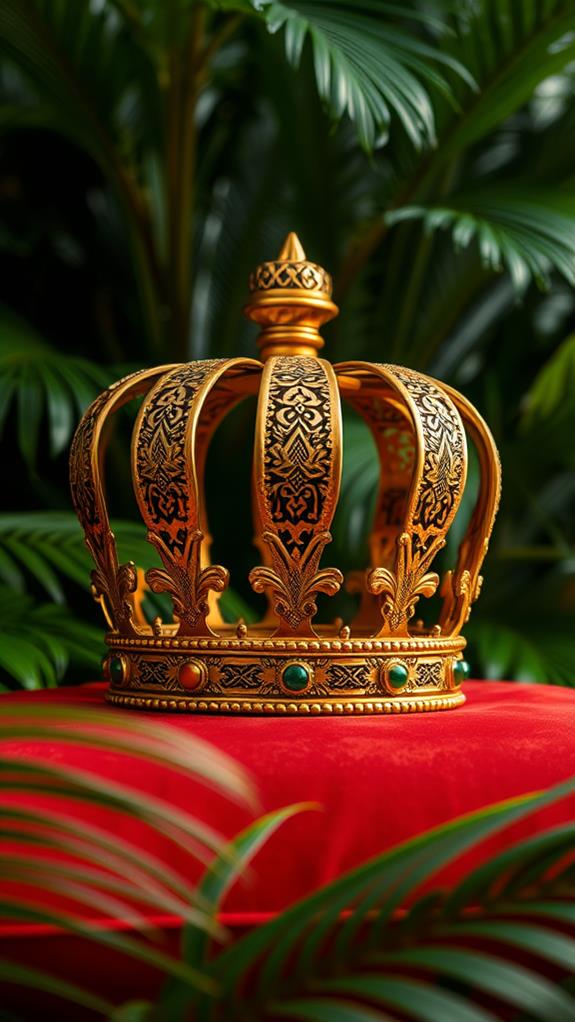
Crowned "King of Pop" during a visit to the Ivory Coast in 1989, Michael Jackson's impact on Africa extended far beyond his music. His performances across the continent drew massive crowds, with a 1996 concert in Dakar, Senegal attracting over 75,000 fans. Jackson's philanthropic efforts in Africa, including donations to children's charities and hosting charity concerts, earned him a revered status among locals.
You might be surprised to learn about Jackson's deep connection to Africa:
- His music, especially "Thriller," resonated strongly with African audiences.
- Local artists created adaptations and tributes to his work.
- In 1997, he became the first major Western artist to perform in post-apartheid South Africa.
Jackson's influence on the continent was multifaceted, combining his musical prowess with humanitarian efforts. His performances weren't just concerts; they were cultural events that brought people together. The "King of Pop" title, bestowed upon him in Africa, reflected not only his musical talents but also his ability to connect with diverse audiences. This coronation solidified Jackson's global appeal and highlighted the significant impact he had on African culture and music.
Soviet Television Appearance
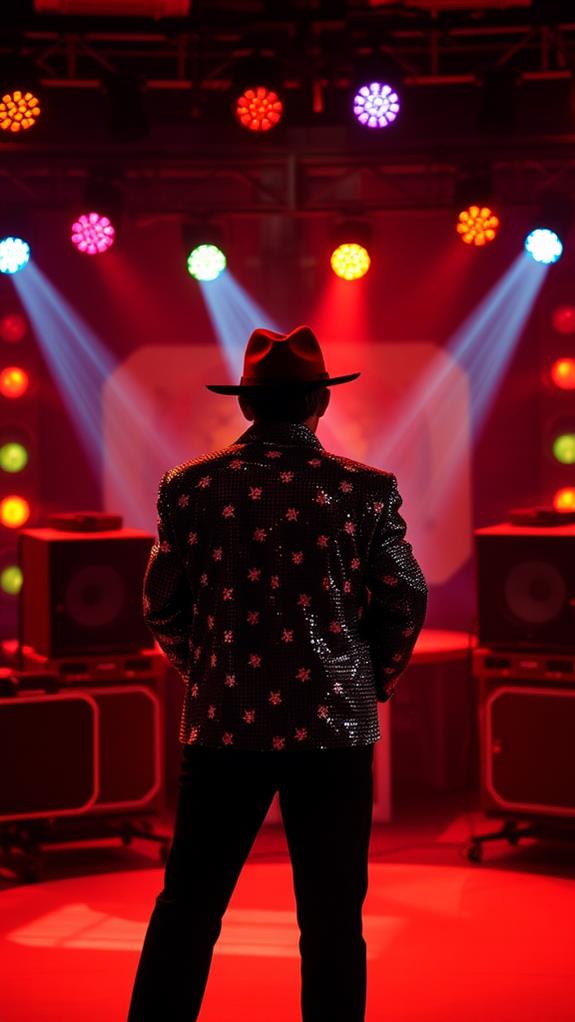
You might not know that Michael Jackson made a groundbreaking appearance on Soviet television in 1988, performing hits like "Black or White" and "The Way You Make Me Feel" during a televised concert in Moscow. This performance was a significant moment in Cold War cultural exchange, as it marked one of the first major U.S. pop star appearances in the USSR. Jackson's concert attracted a massive Soviet audience, showcasing his global appeal and helping to pave the way for future Western artists to perform in Russia.
Groundbreaking Cold War Performance
Michael Jackson's 1988 Soviet television appearance marked a pivotal moment in Cold War cultural exchanges. You might not know that he was the first American artist to perform on Soviet TV, enchanting audiences with his groundbreaking performance. This event showcased the cultural impact of Jackson's music, transcending political boundaries and restrictions on Western entertainment in the Soviet Union.
Here are three key aspects of this historic appearance:
- Jackson performed his hit song "Black or White," demonstrating the universal appeal of his music.
- The televised concert drew massive crowds and favorable reactions from Soviet fans.
- This event helped pave the way for future cultural exchanges between American and Soviet artists.
Jackson's performance on Soviet television was an indication of his global reach and popularity. By appearing in a country where Western music had been limited, he solidified his status as a worldwide cultural icon. This groundbreaking event demonstrated the power of music to bridge cultural divides, even during the tense Cold War era. You can see how Jackson's influence extended far beyond the Western world, making him a truly international superstar.
Televised Concert in Moscow
Building on the impact of his groundbreaking Soviet TV appearance, Jackson's 1997 televised concert in Moscow marked another milestone in his international career. This historic event showcased the King of Pop's global appeal, reaching millions of viewers across Russia. You'd be amazed at how this performance helped foster cultural exchange between the West and post-Soviet Russia.
Here's a quick breakdown of the concert's highlights:
| Feature | Description |
|---|---|
| Iconic Tracks | "Billie Jean," "Black or White" |
| Audience | Millions of Russian viewers |
| Significance | Cultural bridge, Western influence |
| Impact | Lasting impression on Russian music |
The televised concert in Moscow wasn't just another show; it was a cultural phenomenon. Jackson's elaborate staging and choreography captivated fans, leaving an indelible mark on the Russian music scene. You can imagine the excitement of Russian audiences, finally able to experience Western pop influences after years of restriction. This performance solidified Jackson's status as a global pop culture icon, demonstrating his ability to transcend political and cultural boundaries through his music and showmanship.
Impact on Soviet Audience
One of the most pivotal moments in Michael Jackson's international career came with his 1988 Soviet television appearance. The "Moonwalk" concert, broadcast across the USSR, reached an astounding audience of over 100 million viewers. This event showcased Michael Jackson's global appeal and marked a significant cultural exchange during the Cold War era.
Here are three key impacts of Jackson's Soviet television appearance:
- Breaking cultural barriers
- Fostering international understanding
- Expanding his fan base beyond Western borders
You might not realize how groundbreaking this performance was. Jackson's electrifying stage presence and iconic hits like "Billie Jean" and "Beat It" captivated Soviet viewers, who had limited exposure to Western pop culture. His engagement with the Soviet audience helped pave the way for a more open cultural dialogue between the United States and the USSR during a time of political tension.
This televised concert didn't just entertain; it contributed to Jackson's status as a pop culture icon transcending geographical and political boundaries. By reaching millions of viewers behind the Iron Curtain, Jackson's performance demonstrated the power of music to unite people across diverse backgrounds and ideologies.
Marvel Comics Purchase Attempt
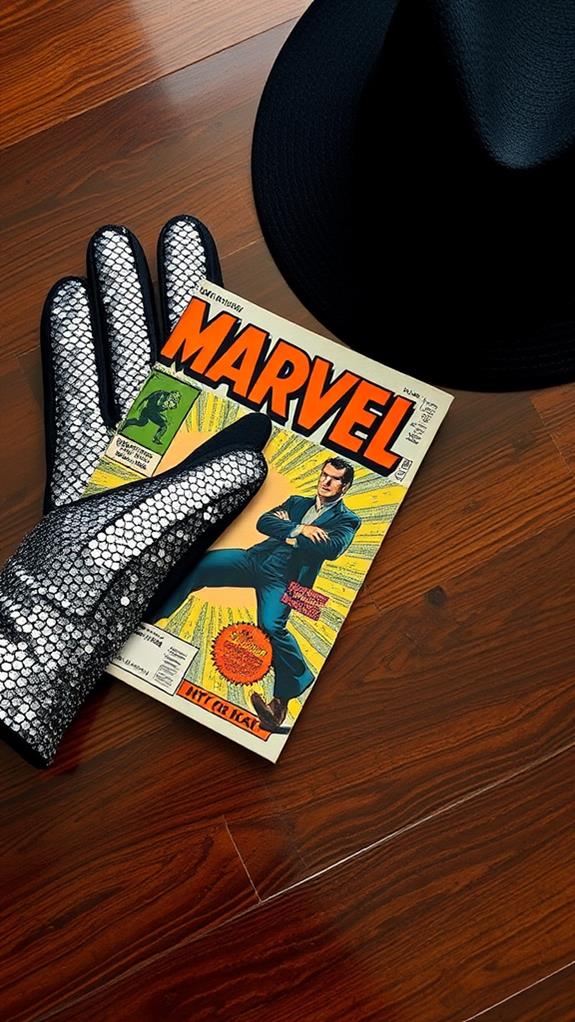
Comic book enthusiasts might be surprised to learn that the King of Pop once set his sights on acquiring Marvel Comics. In the mid-1990s, Michael Jackson, driven by his passion for comic book characters and storytelling, expressed interest in purchasing the iconic publisher. His vision extended beyond mere ownership; Jackson aimed to create a synergy between his music and the Marvel brand, potentially revolutionizing entertainment.
Reports suggest that Jackson offered approximately $25 million for Marvel Comics at the time. This ambitious move was part of his broader strategy to expand his influence beyond the music industry into film and publishing. Jackson's plan included integrating his musical prowess with Marvel's vast universe of characters and narratives, potentially creating a unique blend of audio-visual storytelling.
Although the deal never materialized, it's intriguing to imagine how the landscape of comic book entertainment might have changed under Jackson's ownership. Marvel faced financial difficulties in the late '90s but eventually rebounded. In 2009, shortly after Jackson's death, Disney acquired Marvel, cementing its place in pop culture history. This attempted acquisition remains a fascinating footnote in both Jackson's career and Marvel's corporate history.
Llamas in Recording Studios
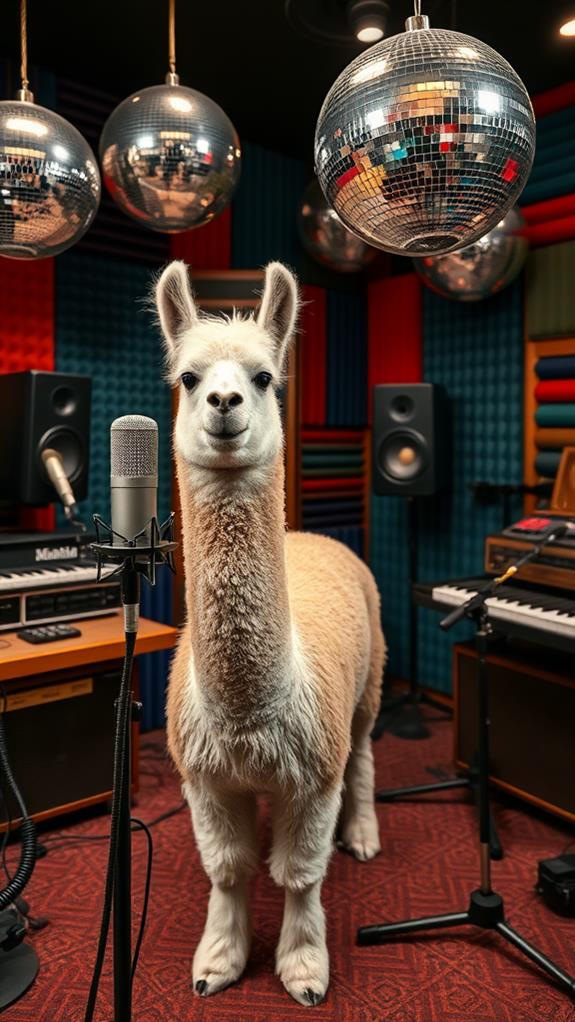
You might be surprised to learn that Michael Jackson had some unusual studio companions during his recording sessions. The King of Pop often brought llamas into the studio, creating a whimsical atmosphere that reflected his unique personality and creative approach. While this practice showcased Jackson's love for animals and his distinctive style, it occasionally caused friction with collaborators, as evidenced by Freddie Mercury's reported annoyance during their 1983 recording sessions.
Unusual Studio Companions
Michael Jackson's recording sessions were far from ordinary, thanks to his unusual studio companions: llamas named Lola and Louis. These unexpected guests became a signature part of Jackson's creative process, reflecting his playful and imaginative approach to music-making. However, not everyone appreciated the presence of these woolly visitors. When collaborating with Jackson in 1983, Freddie Mercury reportedly expressed discomfort with the llamas' regular appearances in the studio.
Jackson's affinity for animals extended beyond his unusual studio companions. His love for wildlife was evident in the design of his Neverland Ranch, which housed a variety of exotic animals. This passion for animals influenced his work environment, creating a unique and whimsical atmosphere that fueled his artistic vision.
Here are three interesting facts about Jackson's unusual studio companions:
- The llamas were named Lola and Louis
- Their presence caused tension with Freddie Mercury during a collaboration
- The llamas' visits became a significant aspect of Jackson's creative process
Today, the inclusion of llamas in Jackson's recording sessions serves as a reflection of his unconventional personality and his commitment to fostering a creative environment that was both playful and imaginative.
Llamas' Impact on Sessions
Three distinct impacts emerged from Jackson's decision to bring llamas into recording sessions. First, the llamas created a unique creative environment at Neverland Ranch. You might imagine the unexpected sight of these animals in a professional studio setting, adding an element of whimsy to the recording process. This unconventional atmosphere likely influenced the mood of the music being created.
Second, the llamas' presence sometimes caused tension among collaborators. The incident with Freddie Mercury in 1983 highlights how not everyone appreciated Jackson's animal companions. This could have affected the dynamics of collaborative sessions and potentially altered the creative output.
Lastly, the llamas became a regular feature in Jackson's recording process, showcasing his eccentric personality and love for animals. This integration of llamas into his creative routine demonstrates Jackson's commitment to fostering an environment that inspired his artistic vision.
Neverland Ranch's Hidden Features

Nestled away from prying eyes, Neverland Ranch held a treasure trove of hidden features that set it apart from any ordinary estate. Michael Jackson's whimsical personality and desire to preserve childhood innocence were evident in every corner of this 3,000-acre wonderland. The centerpiece was a private amusement park, complete with rides and a petting zoo housing exotic animals. This fantastical environment reflected Jackson's vision of a retreat from the pressures of fame.
Here are three hidden features of Neverland Ranch that might surprise you:
- A 50-seat movie theater for private screenings
- A fully functional train station with its own railroad
- Multiple themed gardens scattered throughout the property
You'd find yourself transported to a world reminiscent of J.M. Barrie's "Peter Pan," the inspiration behind the ranch's name. The property boasted a carousel and numerous other attractions designed to create a children's wonderland. Purchased for an estimated $17-$30 million in the late 1980s, Neverland Ranch wasn't just a home; it was Jackson's personal escape, meticulously crafted to embody his love for childhood playfulness and fantasy.
Bubbles the Chimpanzee

Among Michael Jackson's many unconventional companions, none captured the public's imagination quite like Bubbles the chimpanzee. Adopted in 1983 from a research facility, Bubbles quickly became one of the most famous animal companions in pop culture. You might remember seeing him alongside Jackson during tours and special events, symbolizing the singer's deep love for animals.
Bubbles' life at Neverland Ranch was far from ordinary. He was often featured in media appearances, including music videos, which further cemented his status as a celebrity in his own right. Jackson's bond with Bubbles showcased the singer's whimsical personality and his desire for companionship, reflecting the innocence he sought throughout his life.
After Jackson's death, Bubbles' life took a new turn. He was relocated to the Center for Great Apes in Florida, where he now lives in a more natural environment with other apes. This change marks a significant shift from his days in the spotlight, allowing him to experience a life more suited to his species' needs.
Skin Condition Revelation

Michael Jackson's changing appearance was a subject of intense public scrutiny for years, but it wasn't until 1993 that he addressed the root cause. In a groundbreaking interview with Oprah Winfrey, Jackson revealed he had vitiligo, a skin disease that causes patches of skin to lose pigmentation. This revelation shed light on the dramatic changes in his skin tone over the years.
Here are three key points about Jackson's vitiligo:
- It affects approximately 1% of the global population
- It's an autoimmune condition that destroys melanocytes
- It can lead to significant changes in skin appearance
You might be surprised to learn that Jackson's claims were substantiated by the coroner's report following his death in 2009. The report confirmed he indeed had vitiligo, putting to rest years of speculation and controversy surrounding his appearance.
To manage the condition, Jackson often used makeup and skin treatments to even out his skin tone. This led some people to mistakenly believe he was intentionally lightening his skin. In reality, he was trying to cope with a challenging skin disease that had a profound impact on his appearance and public perception.
What Connects John Cabot and Michael Jackson in Terms of Lesser-Known Facts?
While John Cabot and Michael Jackson lived centuries apart, one shared thread is their impact in their realms. Exploring interesting facts about john cabot, he was a pioneer in Atlantic voyages, much like how Jackson redefined global pop. Both left legacies marked by ambition, innovation, and groundbreaking influence in their pursuits.
Michael Jackson Medical Center

While Jackson's skin condition was a significant health concern, it was far from his only medical challenge. You might be surprised to learn that the King of Pop established his own medical facility, the Michael Jackson Medical Center, in Los Angeles. This center was designed to address his numerous health issues and manage chronic pain, especially after a severe commercial accident.
The facility wasn't your typical doctor's office. It was staffed with specialists who catered to Jackson's unique needs, providing both physical and psychological support. Here's a breakdown of the center's key features:
| Feature | Description |
|---|---|
| Purpose | Personal healthcare and support |
| Staffing | Specialized medical professionals |
| Focus | Pain management and health issues |
| Services | Physical and psychological care |
Jackson's relationship with his medical team at the center was reportedly close, as they played a vital role in addressing his ongoing health concerns. However, following his death, the center came under scrutiny. Investigations revealed questionable practices, particularly regarding the prescription of powerful medications like propofol, which ultimately contributed to Jackson's untimely demise.
Frequently Asked Questions
What Did Michael Jackson Like to Do for Fun?
You might be surprised to learn that the King of Pop had some unique ways to unwind. Michael Jackson enjoyed spending time with his animal companions, particularly his chimpanzee Bubbles, at his private zoo. He'd also indulge in amusement park rides right at home, having installed a Ferris wheel and roller coasters at Neverland Ranch. Jackson loved playing arcade-style video games, collecting entertainment memorabilia, and watching classic films. These pastimes influenced his artistic expressions in music and videos.
What Is the Favourite Color of Michael Jackson?
Michael Jackson's favorite color was red. You'll notice this vibrant hue featured prominently in his stage outfits and promotional materials. He often incorporated red into his album art and concert themes, creating a striking visual impact during his performances. Jackson reportedly loved red because it symbolized energy and passion, qualities he admired in his own shows. His iconic red jacket in the "Thriller" music video further cemented his association with this bold color.
How Many People Knew Michael Jackson?
You're asking about how many people knew Michael Jackson, but it's impossible to give an exact number. Instead, consider his global reach. With over 1 billion records sold worldwide, his music touched countless lives. His iconic status, fueled by hit albums like "Thriller," groundbreaking music videos, and distinctive style, made him a household name. Millions watched his performances, and his influence spread across generations. While we can't quantify it precisely, it's safe to say that Michael Jackson was known by hundreds of millions, if not billions, of people worldwide.
How Unique Is Michael Jackson?
You'd be hard-pressed to find an entertainer as unique as Michael Jackson. He's set numerous world records, revolutionized music videos, and even patented dance shoes. His impact extends beyond music, with significant posthumous earnings and philanthropic efforts. Jackson's ability to innovate in performance, technology, and business sets him apart. His cultural influence is so profound that his work is preserved in national archives. While controversial, his uniqueness in the entertainment world remains unparalleled.





